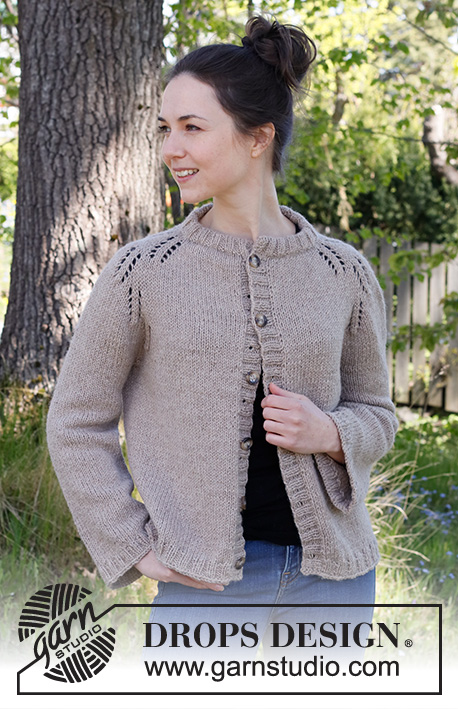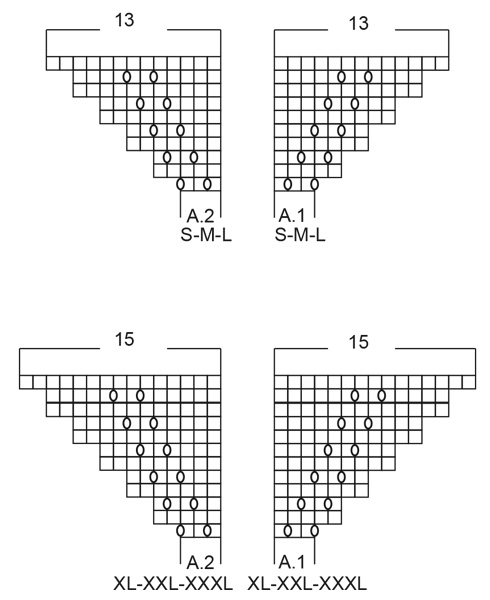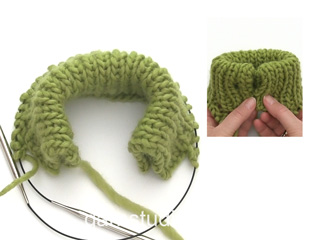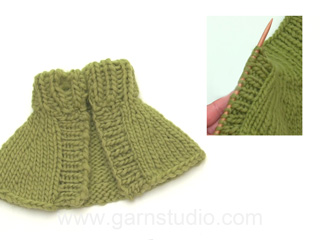Country Life Cardigan |
||||||||||
 |
 |
|||||||||
Knitted jacket in DROPS Nepal. Piece is knitted top down with shoulder increase for saddle shoulder and lace pattern. Size: S - XXXL
DROPS 218-13 |
||||||||||
|
------------------------------------------------------- EXPLANATION FOR THE PATTERN: ------------------------------------------------------- GARTER STITCH (back and forth): Knit all rows. 1 ridge vertically = knit 2 rows. PATTERN: See diagrams A.1 and A.2. Choose diagram for your size. DECREASE TIP (applies to sleeves in size L-XL-XXL-XXXL): Decrease 1 stitch on each side of marker as follows: Work until 3 stitches remain before marker, knit 2 together, knit 2 (marker is between these stitches), slip 1 stitch knitwise, knit 1, pass slipped stitch over stitch worked. BUTTONHOLES: Decrease for 6-6-7-7-7-7 buttonholes on right band. 1 buttonhole = work 2 stitches together, make 1 yarn over - NOTE: It will look nicer if you decrease for buttonhole by purling 2 together in a section with 2 purl stitches (seen from right side). On next row knit yarn over to make holes. Bottom buttonhole should be approx. 4 cm from bottom edge, and top buttonhole approx. 1 cm from neck edge. Place the remaining 4-4-5-5-5-5 buttonholes evenly, approx. 9-9½-8½-8½-9-9½ cm between each buttonhole. CAST-OFF TIP: To avoid a tight cast-off edge you may use a larger needle size. If this also is too tight, work a 1 yarn over after approx. every 4th stitch while casting off (cast off yarn overs as regular stitches). ------------------------------------------------------- START THE PIECE HERE: ------------------------------------------------------- JACKET - SHORT OVERVIEW OF THE PIECE: Worked in one piece from the top down. Fold neck edge double during assembly. Increase out for shoulder and sleeve cap. Now divide yoke for body and sleeves. Work body back and forth on circular needle. Work sleeves in the round on double pointed needles/a short circular needle. NECK EDGE: Cast on 82-86-90-94-98-102 stitches (including 5 band stitches in each side towards mid front) on circular needle size 4.5 mm with Nepal. Purl 1 row from wrong side. Then work rib from right side as follows: Work 1 stitch in GARTER STITCH - read explanation above, knit 1, purl 2, * knit 2, purl 2 *, repeat from *-* until 2 stitches remain, finish with knit 1 and 1 stitch in garter stitch. Continue rib like this for 6 cm. On next row from right side cast off the 5 first stitches, work in stocking stitch and increase 4-8-16-12-24-30 stitches evenly until 5 stitches remain, knit 2, purl 2 and 1 stitch in garter stitch over the last 5 stitches. On next row from wrong side cast off the first 5 stitches work in stocking stitch the rest of row. = 76-84-96-96-112-122 stitches. Switch to circular needle size 5.5 mm. Insert 1 marker at the beginning of row mid front, measure yoke from this marker! YOKE: Now increase stitches on shoulder as follows: SHOULDER INCREASE: Work next row as follows from right side: Work 1 edge stitch in garter stitch, 15-17-20-20-25-27 stitches in stocking stitch (= left front piece), A.1 (= 3 stitches), A.2 (= 3 stitches = left shoulder), 32-36-42-42-48-54 stitches in stocking stitch (= back piece), A.1 over 3 stitches, A.2 over 3 stitches (= right shoulder), 15-17-20-20-25-27 stitches in stocking stitch and finish with 1 edge stitch in garter stitch (= right front piece). REMEMBER THE KNITTING TENSION! When A.1 and A.2 have been worked 1 time vertically, there are 116-124-136-144-160-170 stitches on needle. Work next row as follows from right side: Work 1 edge stitch in garter stitch, 25-27-30-32-37-39 stitches in stocking stitch (= left front piece), A.1 over 3 stitches, A.2 over 3 stitches (= left shoulder), 52-56-62-66-72-78 stitches in stocking stitch (= back piece), A.1 over 3 stitches, A.2 over 3 stitches (= right shoulder), 25-27-30-32-37-39 stitches in stocking stitch and finish with 1 edge stitch in garter stitch (= right front piece). When A.1 and A.2 have been worked 1 time vertically (i.e. 2 times in total vertically), there are 156-164-176-192-208-218 stitches on needle. Piece now measures 10-10-10-12-12-12 cm from marker. SLEEVE INCREASE: Now increase stitches for sleeve cap on next row from right side as follows: Work 1 edge stitch in garter stitch, 25-27-30-32-37-39 stitches in stocking stitch (= left front piece), A.1 over 3 stitches, 20-20-20-24-24-24 stitches in stocking stitch, A.2 over 3 stitches (= left sleeve), 52-56-62-66-72-78 stitches in stocking stitch (= back piece), A.1 over 3 stitches, 20-20-20-24-24-24 stitches in stocking stitch, A.2 over 3 stitches (= right sleeve), 25-27-30-32-37-39 stitches in stocking stitch and finish with 1 edge stitch in garter stitch (= right front piece). When A.1 and A.2 have been worked 1 more time vertically (i.e. 3 times in total including shoulder), there are 196-204-216-240-256-266 stitches on needle. Work next row as follows from right side: Work 1 edge stitch in garter stitch, 25-27-30-32-37-39 stitches in stocking stitch, A.1 over 3 stitches, 40-40-40-48-48-48 stitches in stocking stitch, A.2 over 3 stitches, 52-56-62-66-72-78 stitches in stocking stitch, A.1 over 3 stitches, 40-40-40-48-48-48 stitches in stocking stitch, A.2 over 3 stitches, 25-27-30-32-37-39 stitches in stocking stitch and finish with 1 edge stitch in garter stitch. When A.1 and A.2 have been worked 4 times in total vertically (i.e. 2 times on shoulder and 2 times when increasing for sleeve), there are 236-244-256-288-304-314 stitches on needle. Piece measures approx. 20-20-20-24-24-24 cm from after neck edge. Now work piece in stocking stitch with 1 edge stitch in garter stitch in each side of piece. Increase is now done in size S-M-L-XL-XXL, but continue as follows size XXXL: SIZE XXXL: Insert 1 marker between the 2 stitches between yarn overs in each A.1 and A.2 (= 4 markers). On next row increase 1 stitch in each side of every marker as follows: Work until 1 stitch remains before marker, 1 yarn over (= 1 stitch increased), work 2 stitches in stocking stitch (marker is between these stitches), 1 yarn over (= 1 stitch increased = 8 stitches increased in total on row). Knit yarn overs twisted on next row to avoid holes. Increase like this every row from right side 2 times in total = 330 stitches. ALL SIZES: = 236-244-256-288-304-330 stitches. Then work in stocking stitch with 1 edge stitch in garter stitch in each side of piece. When piece measures 20-22-23-25-27-29 cm from after neck edge, divide piece for body and sleeves as follows: Work 1 edge stitch in garter stitch, 36-37-38-43-46-51 stitches in stocking stitch, slip the next 45-46-50-57-58-62 stitches on a stitch holder for sleeve and cast on 6-8-10-10-12-12 stitches under sleeve, 72-76-78-86-94-102 stitches in stocking stitch, slip the next 45-46-50-57-58-62 stitches on a stitch holder for sleeve and cast on 6-8-10-10-12-12 stitches under sleeve, work 36-37-38-43-46-51 stitches in stocking stitch and finish with 1 edge stitch in garter stitch. BODY: = 158-168-176-194-212-230 stitches. Then work in stocking stitch and 1 edge stitch in garter stitch in each side of piece. When piece measures 25-25-26-26-26-26 cm from where body was divided (or to desired length, approx. 4 cm remain), increase 2-0-0-2-0-2 stitches evenly on next row from wrong side = 160-168-176-196-212-232 stitches. Switch to circular needle size 4.5 mm and work rib as follows, begin from right side: Work 1 edge stitch in garter stitch, * knit 2, purl 2 *, repeat from *-* until 3 stitches remain, finish with knit 2 and 1 edge stitches in garter stitch. Continue like this until rib measures 4 cm. Cast off by knitting - read CAST-OFF TIP. Jacket measures approx. 52-54-56-58-60-62 cm from shoulder. SLEEVES: Slip the 45-46-50-57-58-62 stitches from stitch holder in one side of piece double pointed needles/a short circular needle size 5.5 mm and pick in addition up 1 stitch in each of the 6-8-10-10-12-12 new stitches cast on under sleeve = 51-54-60-67-70-74 stitches. Work in stocking stitch in the round. In size L-XL-XXL-XXXL decreasing as follows: SIZE L-XL-XXL-XXXL: Insert 1 marker in the middle of the 10-10-12-12 stitches cast on under each sleeve. Decrease stitches on each side of this marker later. When sleeve measures 3 cm from division, decrease 1 stitch on each side of marker - read DECREASE TIP. Decrease like this every 12-12-7-5 cm 1-3-4-5 times in total = 58-61-62-64 stitches. ALL SIZES: = 51-54-58-61-62-64 stitches. Work in stocking stitch until piece measures 40-38-37-37-35-33 cm (or desired length, approx. 3 cm remain). On next round increase 13-14-14-11-14-12 stitches evenly = 64-68-72-72-76-76 stitches. Switch to double pointed needles/short circular needle size 4.5 mm. Work rib (= knit 2/purl 2) over all stitches. Cast off by knitting when rib measures 3 cm. Work the other sleeve the same way. LEFT BAND: Begin at the top of neck (i.e. from where stitches on neck edge were cast off) on left front piece, pick up stitches inside 1 edge stitch in garter stitch. Pick up approx. 79-99 stitches (adjust to that number of stitches is divisible by 4 + 3) from right side on circular needle 4.5 mm with Nepal. Work rib, begin from wrong side as follows: 2 stitches in garter stitch, * purl 2, knit 2 *, repeat from *-* until 1 stitch remains, and finish with 1 stitch in garter stitch. Continue rib like this until band measures approx. 3 cm (adjust measurement with stitches cast off on neck edge). Cast off stitches with knit over knit and purl over purl. RIGHT BAND: Begin at the bottom of jacket on right front piece and pick up stitches inside 1 edge stitch in garter stitch. Pick up same number of stitches that were picked up on left band from right side on circular needle size 4.5 mm with Nepal. Work rib, begin from wrong side as follows: Work 1 stitch in garter stitch, * knit 2, purl 2 *, work from *-* until 2 stitches remain, and work 2 stitches in garter stitch. When rib measures approx. 1½ cm, decrease for BUTTONHOLES - see explanation above. Continue rib until band measures 3 cm, adjust measurement with left band. Cast off stitches with knit over knit and purl over purl. ASSEMBLY: Fold rib at the top of neck down on the inside of garment. Fasten rib to form a double folding edge. To avoid a tight neck edge and avoiding the edge to tip outwards, it is important to make the seam elastic. Sew together opening towards mid front on bands with small stitches. Sew the buttons on to the left band. |
||||||||||
Diagram explanations |
||||||||||
|
||||||||||

|
||||||||||

|
||||||||||

|
||||||||||
|
Have you made this or any other of our designs? Tag your pictures in social media with #dropsdesign so we can see them! Do you need help with this pattern?You'll find tutorial videos, a Comments/Questions area and more by visiting the pattern on garnstudio.com. © 1982-2024 DROPS Design A/S. We reserve all rights. This document, including all its sub-sections, has copyrights. Read more about what you can do with our patterns at the bottom of each pattern on our site. |
||||||||||




































































Comments / Questions (1)
Hvorfor kan jeg ikke printe en gratis opskrift ud på papir, men kun gemme den som fil?
29.10.2020 - 15:58DROPS Design answered:
Hei Emma. Du skal fint kunne printe ut oppskriften på papir. Trykk på skriver ikonet under oppskrift. Om du fremdeles har problemer, sjekk innstillingene til din printer. mvh DROPS design
02.11.2020 - 10:58